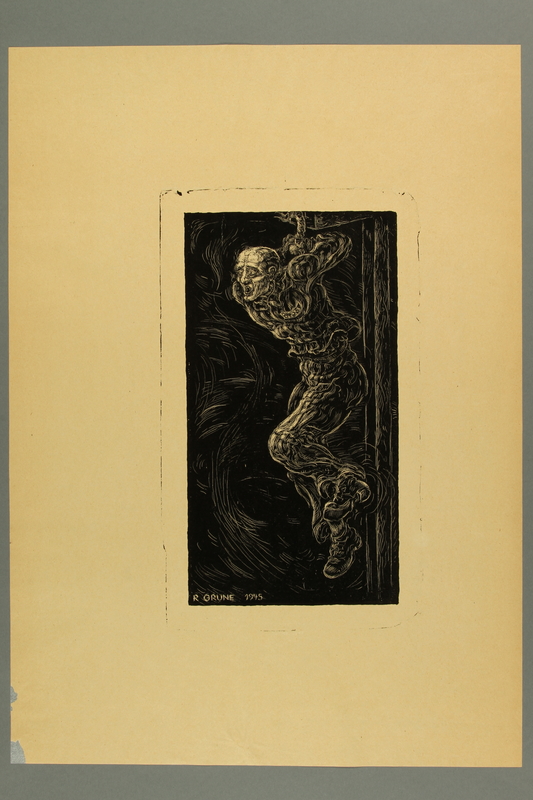Overview
- Brief Narrative
- Lithograph created by Richard Grune soon after the war to publicize the barbaric conditions he experienced or witnessed as a prisoner in concentration camps and prisons in Germany from 1935-1945. Grune was a Bauhaus trained artist who moved to Berlin in February 1933. Hitler had been appointed Chancellor that January and was transforming the government to a Nazi-controlled dictatorship. Nazi ideology demanded racial and cultural purity and homosexuality was antithetical to this vision. Under the new government, those suspected of violating a pre-existing statute, Article 6, §175, which punished indecent acts between men, were targeted for arrest. In December 1934, Grune was denounced and arrested. Under interrogation, he admitted to being homosexual. He was held in protective custody for five months, then put on trial for violating §175. In September 1936, he was convicted and sentenced to prison. Upon his release, the Gestapo kept Grune in protective custody, asserting that his sentence had been too lenient. In October 1937, Grune was sent to Sachsenhausen concentration camp. In April 1940, he was transferred to Flossenbürg. Five years later, in April 1945, as American forces approached, the camp was evacuated and Grune escaped. He began work on a series of artwork to show the horrific conditions of the German-run camps to the world. In 1947, the works were exhibited and published as Passion des xx. jahrhunderts, one of the most important records of Nazi brutality published in the immediate postwar period.
- Date
-
creation:
after 1945 April-1945 December
- Geography
-
depiction:
concentration camp;
Germany
creation: Kiel (Germany)
- Credit Line
- United States Holocaust Memorial Museum Collection, The Abraham and Ruth Goldfarb Family Acquisition Fund
- Contributor
-
Artist:
Richard Grune
Subject: Richard Grune
- Biography
-
Richard Grune was born on August 2, 1903, in Flensburg, Germany. He attended the Municipal Arts and Craft School in Kiel. In 1926, he studied at the Bauhaus school in Weimar, and later Dessau, where his teachers included Paul Klee and Wassily Kandinsky. He worked as a painter and photographer. Grune moved to Berlin in February 1933. Hitler had been appointed Chancellor in January that year and the country was rapidly shifting into a Nazi controlled dictatorship. Nazi ideology called for the racial and cultural purification of Germany and, in debates in the Reichstag, Nazi party members had already made clear their position that homosexuality was antithetical to a strong Germany. Under the new government, police were enforcing the existing law, Article 6, § 175, which punished indecent acts between men. Same-sex clubs were being shut down and those suspected of violating the law were being targeted for arrest. Grune was arrested in December 1934, one of seventy caught in a wave of denunciations. Under interrogation, Grune admitted to being homosexual. He was held in protective custody for five months, then returned to his childhood home in Flensburg to stand trial for violating §175. In September 1936, Grune was convicted and sentenced to prison in Lichtenburg. Upon his release, the Gestapo kept Grune in protective custody, asserting that his sentence had been too lenient. In early October 1937, Grune was sent to Sachsenhausen concentration camp. In early April 1940, he was transferred to Flossenbürg.
In April 1945, as American forces approached, Grune escaped during the evacuation of the camp and joined his sister in Kiel. He began creating the works that would be exhibited and published as "Passion des XX. Jahrhunderts" (Passion of the 20th century). The set of lithographs was, one of the earliest and most important works to detail the horrific conditions and brutality of the German concentration camp system to the public. Grune spent much of the remainder of his life in Spain, but later returned to Germany. Grune, 80, died on November 26, 1983, in Hamburg.
Physical Details
- Classification
-
Art
- Category
-
Prints
- Object Type
-
Lithographs (aat)
- Physical Description
- Expressionistic lithograph in black ink depicting a man in a striped uniform with a number on his jacket pocket, chained and hanging from pole. Printed in the upper left hand side of the image is the artist's signature and date " R. GRUNE 1945."
- Dimensions
- overall: Height: 16.375 inches (41.593 cm) | Width: 22.750 inches (57.785 cm)
- Materials
- overall : paper, ink, graphite
Rights & Restrictions
- Conditions on Access
- No restrictions on access
- Conditions on Use
- Restrictions on use
Keywords & Subjects
- Topical Term
- Concentration camps in art. Concentration camps--Pictorial works. Concentration camp inmates--Germany--Biography. Gay artists--Nazi persecution--Germany--Biography. Gays--Nazi persecution--Germany--Biography. Political prisoners--Germany--Biography.
- Personal Name
- Grune, Richard, 1903-1983.
Administrative Notes
- Legal Status
- Permanent Collection
- Provenance
- The lithograph was acquired by the United States Holocaust Memorial Museum in 2012.
- Funding Note
- The acquisition of this collection was made possible by The Abraham and Ruth Goldfarb Family Acquisition Fund.
- Record last modified:
- 2022-11-10 08:51:33
- This page:
- https://collections.ushmm.org/search/catalog/irn50601
Download & Licensing
In-Person Research
- By Appointment
- Request 21 Days in Advance of Visit
- Plan a Research Visit
- Request to See This Object
Contact Us
Also in Richard Grune collection
The collection consists of eleven lithographs created by Richard Grune based upon his experiences as a prisoner in Sachsenhausen and Flossenburg concentration camps in Germany from 1937-1945.
Date: 1945

Richard Grune lithograph of a concentration camp guard beating a prisoner
Object
Lithograph created by Richard Grune soon after the war to publicize the barbaric conditions he experienced or witnessed as a prisoner in concentration camps and prisons in Germany from 1935-1945. Grune was a Bauhaus trained artist who moved to Berlin in February 1933. Hitler had been appointed Chancellor that January and was transforming the government to a Nazi-controlled dictatorship. Nazi ideology demanded racial and cultural purity and homosexuality was antithetical to this vision. Under the new government, those suspected of violating a pre-existing statute, Article 6, §175, which punished indecent acts between men, were targeted for arrest. In December 1934, Grune was denounced and arrested. Under interrogation, he admitted to being homosexual. He was held in protective custody for five months, then put on trial for violating §175. In September 1936, he was convicted and sentenced to prison. Upon his release, the Gestapo kept Grune in protective custody, asserting that his sentence had been too lenient. In October 1937, Grune was sent to Sachsenhausen concentration camp. In April 1940, he was transferred to Flossenbürg. Five years later, in April 1945, as American forces approached, the camp was evacuated and Grune escaped. He began work on a series of artwork to show the horrific conditions of the German-run camps to the world. In 1947, the works were exhibited and published as Passion des xx. jahrhunderts, one of the most important records of Nazi brutality published in the immediate postwar period.
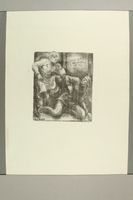
Richard Grune lithograph of a concentration camp guard threatening a cowering prisoner
Object
Lithograph created by Richard Grune soon after the war to publicize the barbaric conditions he experienced or witnessed as a prisoner in concentration camps and prisons in Germany from 1935-1945. Grune was a Bauhaus trained artist who moved to Berlin in February 1933. Hitler had been appointed Chancellor that January and was transforming the government to a Nazi-controlled dictatorship. Nazi ideology demanded racial and cultural purity and homosexuality was antithetical to this vision. Under the new government, those suspected of violating a pre-existing statute, Article 6, §175, which punished indecent acts between men, were targeted for arrest. In December 1934, Grune was denounced and arrested. Under interrogation, he admitted to being homosexual. He was held in protective custody for five months, then put on trial for violating §175. In September 1936, he was convicted and sentenced to prison. Upon his release, the Gestapo kept Grune in protective custody, asserting that his sentence had been too lenient. In October 1937, Grune was sent to Sachsenhausen concentration camp. In April 1940, he was transferred to Flossenbürg. Five years later, in April 1945, as American forces approached, the camp was evacuated and Grune escaped. He began work on a series of artwork to show the horrific conditions of the German-run camps to the world. In 1947, the works were exhibited and published as Passion des xx. jahrhunderts, one of the most important records of Nazi brutality published in the immediate postwar period.

Richard Grune lithograph of a group of concentration prisoners gathered around 2 dead comrades
Object
Lithograph created by Richard Grune soon after the war to publicize the barbaric conditions he experienced or witnessed as a prisoner in concentration camps and prisons in Germany from 1935-1945. Grune was a Bauhaus trained artist who moved to Berlin in February 1933. Hitler had been appointed Chancellor that January and was transforming the government to a Nazi-controlled dictatorship. Nazi ideology demanded racial and cultural purity and homosexuality was antithetical to this vision. Under the new government, those suspected of violating a pre-existing statute, Article 6, §175, which punished indecent acts between men, were targeted for arrest. In December 1934, Grune was denounced and arrested. Under interrogation, he admitted to being homosexual. He was held in protective custody for five months, then put on trial for violating §175. In September 1936, he was convicted and sentenced to prison. Upon his release, the Gestapo kept Grune in protective custody, asserting that his sentence had been too lenient. In October 1937, Grune was sent to Sachsenhausen concentration camp. In April 1940, he was transferred to Flossenbürg. Five years later, in April 1945, as American forces approached, the camp was evacuated and Grune escaped. He began work on a series of artwork to show the horrific conditions of the German-run camps to the world. In 1947, the works were exhibited and published as Passion des xx. jahrhunderts, one of the most important records of Nazi brutality published in the immediate postwar period.
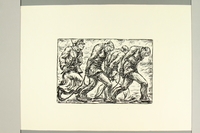
Richard Grune woodcut of a guard marching roped concentration camp prisoners
Object
Lithograph created by Richard Grune soon after the war to publicize the barbaric conditions he experienced or witnessed as a prisoner in concentration camps and prisons in Germany from 1935-1945. Grune was a Bauhaus trained artist who moved to Berlin in February 1933. Hitler had been appointed Chancellor that January and was transforming the government to a Nazi-controlled dictatorship. Nazi ideology demanded racial and cultural purity and homosexuality was antithetical to this vision. Under the new government, those suspected of violating a pre-existing statute, Article 6, §175, which punished indecent acts between men, were targeted for arrest. In December 1934, Grune was denounced and arrested. Under interrogation, he admitted to being homosexual. He was held in protective custody for five months, then put on trial for violating §175. In September 1936, he was convicted and sentenced to prison. Upon his release, the Gestapo kept Grune in protective custody, asserting that his sentence had been too lenient. In October 1937, Grune was sent to Sachsenhausen concentration camp. In April 1940, he was transferred to Flossenbürg. Five years later, in April 1945, as American forces approached, the camp was evacuated and Grune escaped. He began work on a series of artwork to show the horrific conditions of the German-run camps to the world. In 1947, the works were exhibited and published as Passion des xx. jahrhunderts, one of the most important records of Nazi brutality published in the immediate postwar period.

Richard Grune lithograph of concentration camp prisoners throwing dead bodies into a fire
Object
Lithograph created by Richard Grune soon after the war to publicize the barbaric conditions he experienced or witnessed as a prisoner in concentration camps and prisons in Germany from 1935-1945. Grune was a Bauhaus trained artist who moved to Berlin in February 1933. Hitler had been appointed Chancellor that January and was transforming the government to a Nazi-controlled dictatorship. Nazi ideology demanded racial and cultural purity and homosexuality was antithetical to this vision. Under the new government, those suspected of violating a pre-existing statute, Article 6, §175, which punished indecent acts between men, were targeted for arrest. In December 1934, Grune was denounced and arrested. Under interrogation, he admitted to being homosexual. He was held in protective custody for five months, then put on trial for violating §175. In September 1936, he was convicted and sentenced to prison. Upon his release, the Gestapo kept Grune in protective custody, asserting that his sentence had been too lenient. In October 1937, Grune was sent to Sachsenhausen concentration camp. In April 1940, he was transferred to Flossenbürg. Five years later, in April 1945, as American forces approached, the camp was evacuated and Grune escaped. He began work on a series of artwork to show the horrific conditions of the German-run camps to the world. In 1947, the works were exhibited and published as Passion des xx. jahrhunderts, one of the most important records of Nazi brutality published in the immediate postwar period.

Richard Grune lithograph of a concentration camp prisoner crouched near barbed wire
Object
Lithograph created by Richard Grune soon after the war to publicize the barbaric conditions he experienced or witnessed as a prisoner in concentration camps and prisons in Germany from 1935-1945. Grune was a Bauhaus trained artist who moved to Berlin in February 1933. Hitler had been appointed Chancellor that January and was transforming the government to a Nazi-controlled dictatorship. Nazi ideology demanded racial and cultural purity and homosexuality was antithetical to this vision. Under the new government, those suspected of violating a pre-existing statute, Article 6, §175, which punished indecent acts between men, were targeted for arrest. In December 1934, Grune was denounced and arrested. Under interrogation, he admitted to being homosexual. He was held in protective custody for five months, then put on trial for violating §175. In September 1936, he was convicted and sentenced to prison. Upon his release, the Gestapo kept Grune in protective custody, asserting that his sentence had been too lenient. In October 1937, Grune was sent to Sachsenhausen concentration camp. In April 1940, he was transferred to Flossenbürg. Five years later, in April 1945, as American forces approached, the camp was evacuated and Grune escaped. He began work on a series of artwork to show the horrific conditions of the German-run camps to the world. In 1947, the works were exhibited and published as Passion des xx. jahrhunderts, one of the most important records of Nazi brutality published in the immediate postwar period.
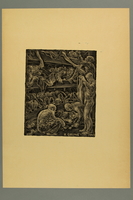
Richard Grune lithograph of concentration camp prisoners in a barracks
Object
Lithograph created by Richard Grune soon after the war to publicize the barbaric conditions he experienced or witnessed as a prisoner in concentration camps and prisons in Germany from 1935-1945. Grune was a Bauhaus trained artist who moved to Berlin in February 1933. Hitler had been appointed Chancellor that January and was transforming the government to a Nazi-controlled dictatorship. Nazi ideology demanded racial and cultural purity and homosexuality was antithetical to this vision. Under the new government, those suspected of violating a pre-existing statute, Article 6, §175, which punished indecent acts between men, were targeted for arrest. In December 1934, Grune was denounced and arrested. Under interrogation, he admitted to being homosexual. He was held in protective custody for five months, then put on trial for violating §175. In September 1936, he was convicted and sentenced to prison. Upon his release, the Gestapo kept Grune in protective custody, asserting that his sentence had been too lenient. In October 1937, Grune was sent to Sachsenhausen concentration camp. In April 1940, he was transferred to Flossenbürg. Five years later, in April 1945, as American forces approached, the camp was evacuated and Grune escaped. He began work on a series of artwork to show the horrific conditions of the German-run camps to the world. In 1947, the works were exhibited and published as Passion des xx. jahrhunderts, one of the most important records of Nazi brutality published in the immediate postwar period.

Richard Grune lithograph of a concentration camp guard and a prisoner with a noose in the background
Object
Lithograph created by Richard Grune soon after the war to publicize the barbaric conditions he experienced or witnessed as a prisoner in concentration camps and prisons in Germany from 1935-1945. Grune was a Bauhaus trained artist who moved to Berlin in February 1933. Hitler had been appointed Chancellor that January and was transforming the government to a Nazi-controlled dictatorship. Nazi ideology demanded racial and cultural purity and homosexuality was antithetical to this vision. Under the new government, those suspected of violating a pre-existing statute, Article 6, §175, which punished indecent acts between men, were targeted for arrest. In December 1934, Grune was denounced and arrested. Under interrogation, he admitted to being homosexual. He was held in protective custody for five months, then returned to his childhood home to stand trial for violating §175. In September 1936, he was convicted and sentenced to prison. Upon his release, the Gestapo kept Grune in protective custody, asserting that his sentence had been too lenient. In October 1937, Grune was sent to Sachsenhausen concentration camp. In April 1940, he was transferred to Flossenbürg. Five years later, in April 1945, as American forces approached, the camp was evacuated and Grune escaped. He began work on a series of artwork to show the horrific conditions of the German-run camps to the world. In 1947, the works were exhibited and published as Passion des xx. jahrhunderts, one of the most important records of Nazi brutality published in the immediate postwar period.

Richard Grune lithograph of a torture scene witnessed in a concentration camp
Object
Lithograph created by Richard Grune soon after the war to publicize the barbaric conditions he experienced or witnessed as a prisoner in concentration camps and prisons in Germany from 1935-1945. Grune was a Bauhaus trained artist who moved to Berlin in February 1933. Hitler had been appointed Chancellor that January and was transforming the government to a Nazi-controlled dictatorship. Nazi ideology demanded racial and cultural purity and homosexuality was antithetical to this vision. Under the new government, those supected of violating a pre-existing statute, Article 6, §175, which punished indecent acts between men, were targeted for arrest. In December 1934, Grune was denounced and arrested. Under interrogation, he admitted to being homosexual. He was held in protective custody for five months, then put on for violating §175. In September 1936, he was convicted and sentenced to prison. Upon his release, the Gestapo kept Grune in protective custody, asserting that his sentence had been too lenient. In October 1937, Grune was sent to Sachsenhausen concentration camp. In April 1940, he was transferred to Flossenbürg. Five years later, in April 1945, as American forces approached, the camp was evacuated and Grune escaped. He began work on a series of artwork to show the horrific conditions of the German-run camps to the world. In 1947, the works were exhibited and published as Passion des xx. jahrhunderts, one of the most important records of Nazi brutality published in the immediate postwar period.
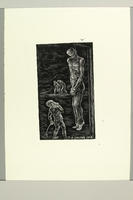
Richard Grune lithograph with an image of a child looking at a hanging victim
Object
Lithograph created by Richard Grune soon after the war to publicize the barbaric conditions he experienced or witnessed as a prisoner in concentration camps and prisons in Germany from 1935-1945. Grune was a Bauhaus trained artist who moved to Berlin in February 1933. Hitler had been appointed Chancellor that January and was transforming the government to a Nazi-controlled dictatorship. Nazi ideology demanded racial and cultural purity and homosexuality was antithetical to this vision. Under the new government, those suspected of violating a pre-existing statute, Article 6, §175, which punished indecent acts between men, were targeted for arrest. In December 1934, Grune was denounced and arrested. Under interrogation, he admitted to being homosexual. He was held in protective custody for five months, then put on trial for violating §175. In September 1936, he was convicted and sentenced to prison. Upon his release, the Gestapo kept Grune in protective custody, asserting that his sentence had been too lenient. In October 1937, Grune was sent to Sachsenhausen concentration camp. In April 1940, he was transferred to Flossenbürg. Five years later, in April 1945, as American forces approached, the camp was evacuated and Grune escaped. He began work on a series of artwork to show the horrific conditions of the German-run camps to the world. In 1947, the works were exhibited and published as Passion des xx. jahrhunderts, one of the most important records of Nazi brutality published in the immediate postwar period.

